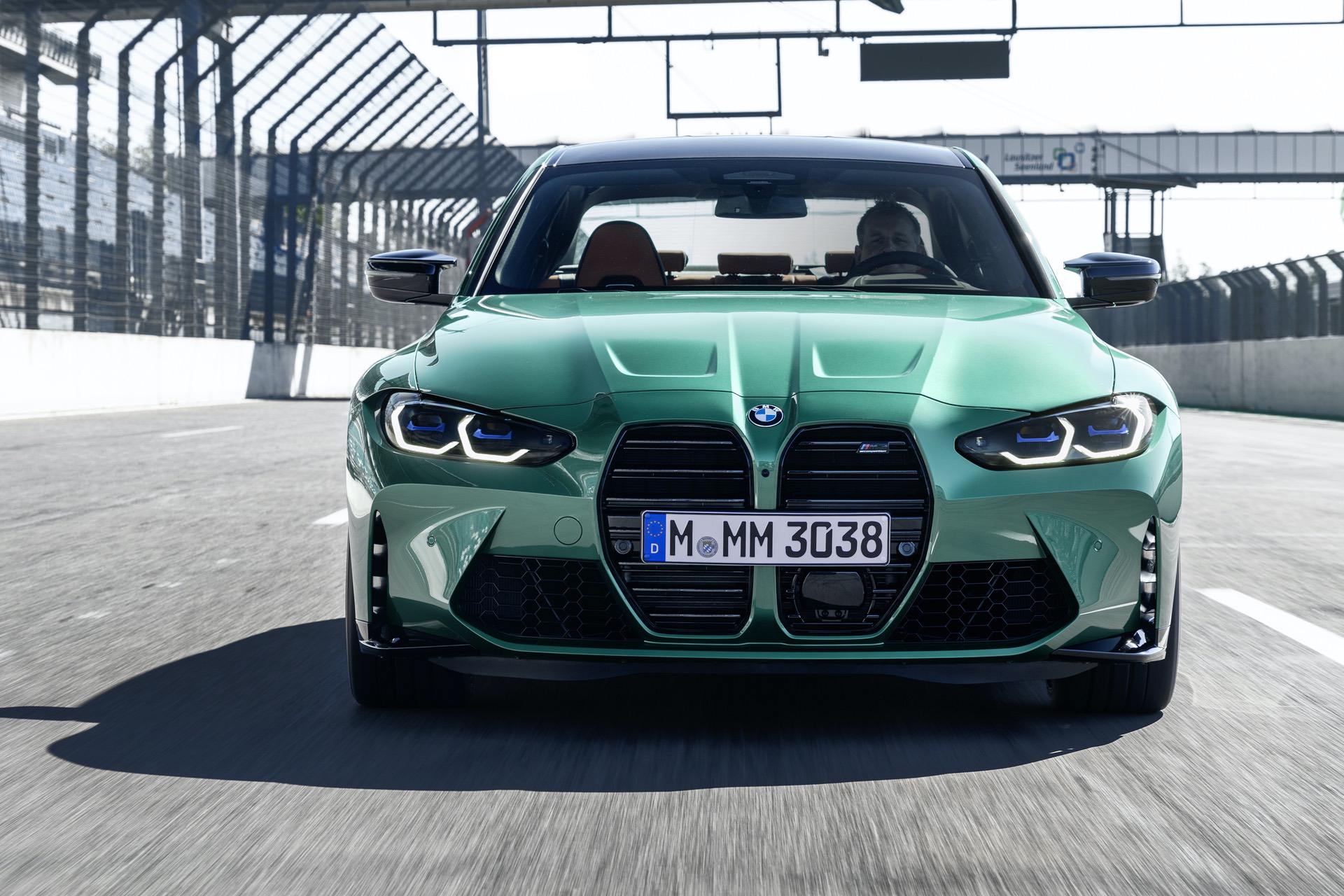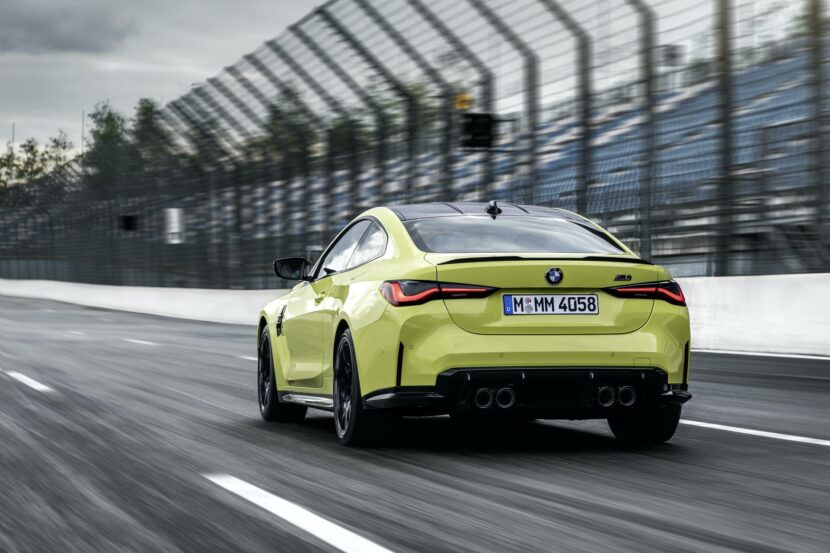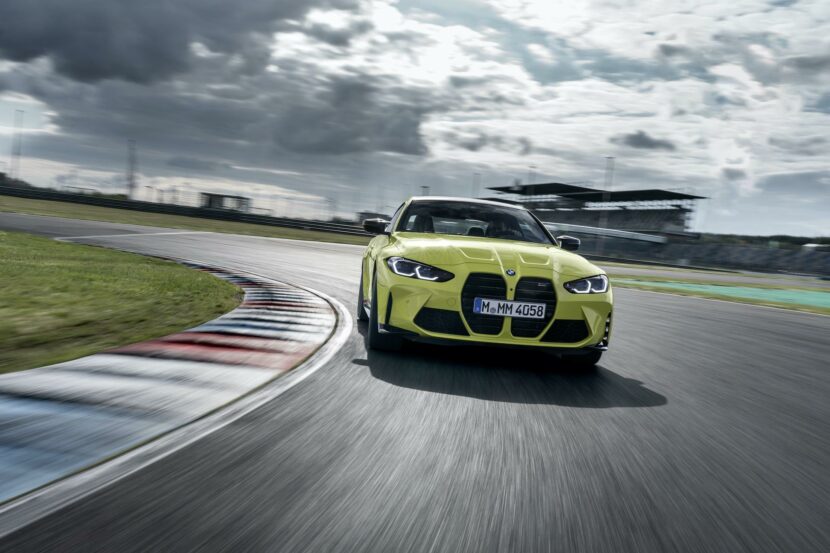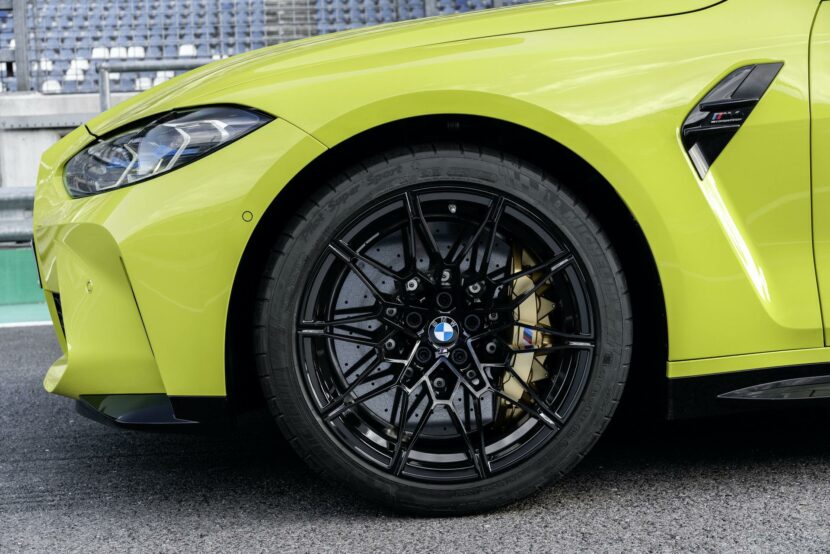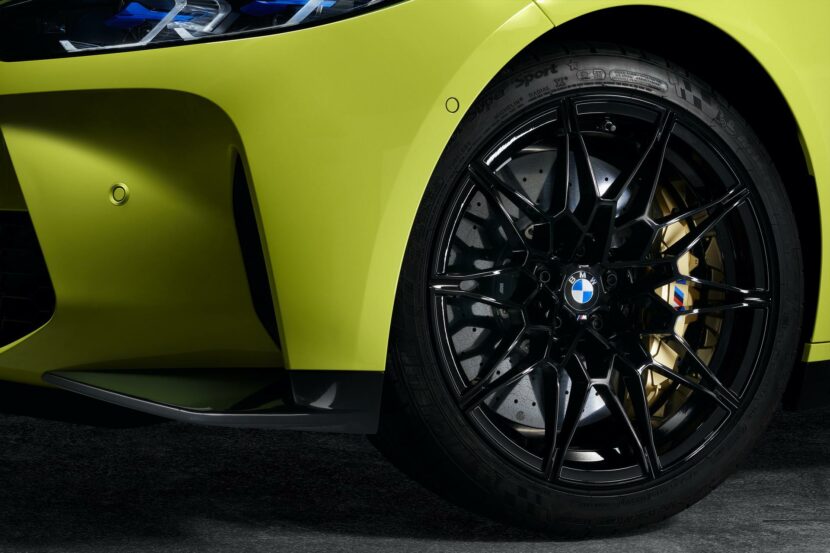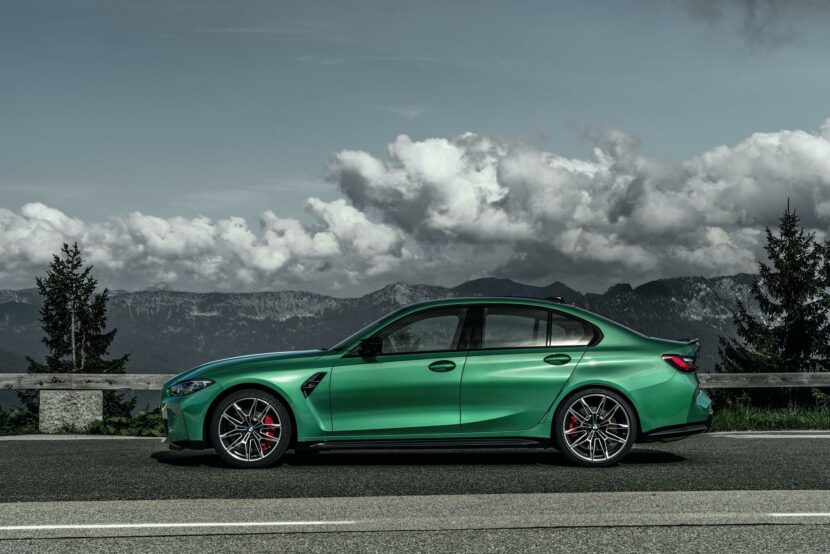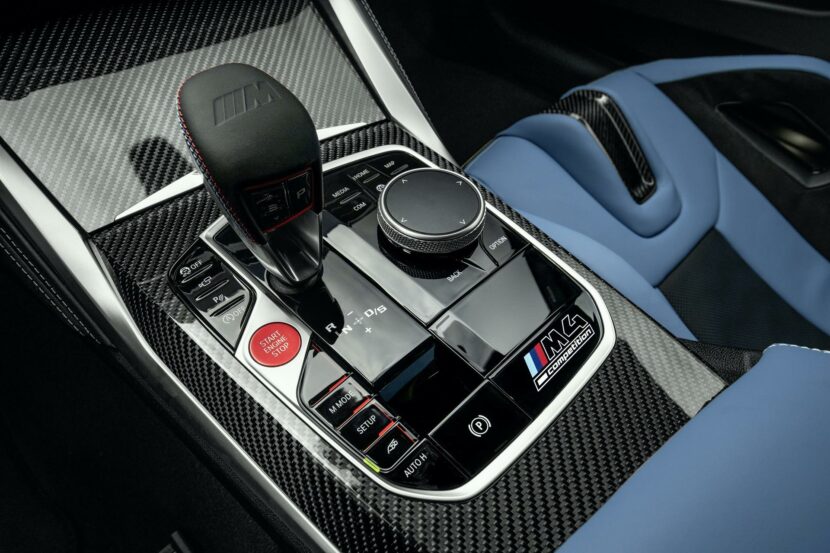The new generation of the M3 and M4 boast a thoroughly reengineered chassis, that ensures exceptional body stiffness, increased torsional rigidity, an ideal 50:50 weight distribution, an all-rounding stability and dynamics-focused, high-performance driving character.
The pre-series prototypes of the G80 M3 and G82 M4 generations have been intensively tested and tweaked at the BMW Group Miramas facility in southern France, on the relentless Nurburgring Nordschleife in Germany and around the winter testing centre in Arjeplog, Sweden.
The chassis of the new M3 and M4, together with all its components, the high-performance M-specific braking system and the fully Adaptive M suspension have been deeply inspired from the world of motor racing. Actually, the new generation of M automobiles in the premium mid-class segment have been developed together with the 2022 BMW M4 GT3 endurance race car.
Bespoke chassis development and consistent technology transfer from the future M4 GT3
The new M3 and M4 models achieve an outstanding level of structural rigidity thanks to the specifically-designed bracing elements developed in pure BMW M style. In this way, the longitudinal and torsional stiffness are brought to a new level.
The increased dimensions in both length and width have allowed for the development of new, state-of-the-art mechanical components. The individual spring strut towers are both inter-connected and also solidly linked to the car nose and bulkhead. The rigidity-ensuring elements of the engine bay are bonded to front axle subframe using vertical bracings. The connection point is positioned in the lower section of the A-pillar.
The front axle subframe is manufactured out of aluminum and consists of a single-piece aluminum shear panel with integrated sill braces for extra stiffness. The underfloor bracing elements for the center and rear sections of the chassis include a cross-bar, extensive load compartment stiffening measures and a bespoke rear axle subframe with a rigid connection to the body.
The spring strut of the front axle feature a double-joint architecture, employing new aluminum wishbones with ball joints, an aluminum torque arm with newly-developed mounting, a forged swivel bearing with bespoke spring strut clamp and lightweight wheel bearings with very high camber stability.
The specific front axle kinematics, emphasized by the large castor and kingpin angles, together with a lowered roll centre decisively improve the comfort and dynamics potential and ensure a competitive trade-off in daily, normal driving. The rear axle comes with a five-link architecture and newly developed wheel carriers and wishbones, which further improve handling characteristics.
The directional stability and the performance-focused character are radically enhanced thanks to the wider track and tyre widths and longer wheelbase in the case of the M3 and M4 models, compared to their predecessors. In this way, the two new BMW M models are perfectly fitted to ensure both a great level of hallmark M dynamics and complete safety and predictability during normal and extreme driving.
Dramatically-improved handling: the M Servotronic steering system
The drastically tweaked chassis and body ensuring an unprecedented amount of torsional rigidity are complemented with the pioneering M Servotronic steering system, which is precisely developed to suit the high-performance aura of the new M3 Sedan and M4 Coupe.
The M Servotronic steering basically combines the qualities of the speed-sensitive Electric Power Steering employed in non-M BMW cars with a variable steering ratio. The amount of steering torque needed to turn the wheel is thus optimally calculated and made available to the driver.
The performance-oriented steering system offers substantial benefits in all situations and especially during dynamic cornering and parking at low speeds. Due to closely-positioned steering rack teeth when the wheel angle exceeds a certain value, the steering effort and driver’s input is considerably reduced, while maintaining the same level of steering precision and maneuvering accuracy.
Like many other functions and systems, the M Servotronic steering can also be adjusted via the M Setup menu. Two steering modes are available: COMFORT and SPORT. In the COMFORT mode, the force needed to steer the wheels is minimal, thus making it ideal for everyday driving. In SPORT, the steering hardens up for more precise handling and safe dynamic cornering.
Adaptive M Suspension with increased damping capabilities
The 2021 M3 Sedan and M4 Coupe feature the Adaptive M Suspension as part of the standard equipment. The system is equipped with electronically controlled dampers and maximizes traction and grip under all road situations.
The control unit of the Adaptive M Suspension gathers an array of sensors that infinitely adjust the damping force based on the road condition, steering adjustments and body movements. This is accomplished by means of electromagnetically controlled valves, that act in a matter o milliseconds to deliver the required damping force.
Using the M Setup menu, you can as well adjust the adaptive M suspension to three different modes: COMFORT, SPORT and SPORT PLUS. The first ensures an adequate balance between a comfortable and sporty behavior. SPORT was specifically developed on the Nurburgring track for stiffer damper responses, whereas the SPORT PLUS is suitable mostly for use on the race circuits and for pushing the agility of the car to unthinkable limits.
High-end M-specific braking system with two pedal feel settings
BMW M equips the brand new G80 and G82 model series with a tailored high-performance, integrated braking system which, for the first time, enables the driver to choose between two different settings for the pedal feel.
The new M3 and M4 generations come with standard M Compound brakes. These brakes feature an optimal, heat- and fade-resistant architecture with six-piston caliper brakes with 380-millimeter discs at the front and single-piston floating-caliper brakes (including parking brake) with 370-millimeter discs at the rear.
The M Compound braking system is visually distinguished by the standard Blue calipers bearing the M logo. Optionally, they can also specced in Red or Black color, also featuring the emblem of the Garching-based high-performance division.
Apart from the M Compound brakes, the M Carbon ceramic brakes are also made available for the new M3 Sedan and M4 Coupe. Their calipers – painted in Gold metallic – engage with 400-millimeter discs at the front axle and 380-millimeter items at the rear.
In all cases, the braking functionality is controlled with the help of a compact management module which gathers the braking actuation, the braking force assistance and the braking control functions. Braking is performed by means of electric actuators, which calculate the necessary amount of braking pressure depending on the situation.
The M braking system is never susceptible to fading or reduction in efficiency due to slippery road conditions. Furthermore, it allows for a comfortable and predictable braking, that matches the driving style and the dynamic aura of the new M3 and M4. Likewise, the two available settings for the M braking system can be adjusted via the M Setup menu: COMFORT for normal-day driving and SPORT for an instantaneous, powerful brake response.
A consistent lineup of M light-alloy wheels
The G80/G82 BMW M3 Sedan and M4 Coupe propose a novel, motorsport-inspired recipe when it comes to wheel dimensions: the larger-diameter for the rear wheels, a solution previously applied on the M4 GTS and M4 CS special editions of the preceding F82 generation.
In standard form, the G80 M3 and G82 M4 are equipped with 275/40 ZR18 M light alloys at the front and 285/35 ZR19 items at the rear. At the same time, the Competition range-toppers equipped with the M xDrive come with M light-alloy wheels as standard: 275/35 ZR19 at front and 285/30 ZR20 at the rear.
The respective tyre dimensions will also become available in the future for the rear-wheel drive M3 and M4 models. In addition, the selection of wheels and tyres also include M Performance choices, specifically intended for racetrack use.
DSC with M Dynamic Mode and ten-stage traction control
The renowned DSC system works in complete harmony with the integrated M braking system, the ABS, the CBC (Cornering Brake Control), Automatic Differential Brake (ADB-X), Brake Assist, Dry Braking and Start-Off Assistant functions. In the Competition models, the additional Automatic Hold function is also offered.
The stability control system helps improve traction and vehicle stability in difficult road surfaces, such as those covered with snow or ice or having imperfect friction characteristics. The predictable control over wet surfaces is significantly improved thanks to the integrated wheel slip limitation function.
On the new M3 and M4, the slip control function previously found in the DSC control unit has been relocated to the engine management unit, which now delivers more effective results, which further improves propulsion and overall traction. The DSC system is also conveniently interlinked with the Active M Differential and – in models with M xDrive – with the full variable, electronic all-wheel-drive system.
In the M Dynamic Mode, accessible via a physical button on the center console, the DSC is more permissive and allows for more driving. The greater degree of wheel slip opens the way to an exceptionally rich driving experience by allowing the driver to perform controlled drifts. Of course, there is also the possibility to completely disengage the DSC by using the available DSC Off mode.
The optional M Drive Professional package making its debut on the new M3 Sedan and M4 Coupe also comprises the M Traction Control function, which enables a fine management of the wheel slip ability in up to ten progressive stages, that can be configured through the iDrive control menu.


